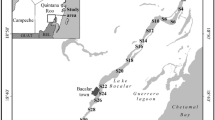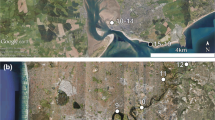Summary
Analysis of samples from a 15 m deep sandy bottom in the northern part of Øresund, Denmark shows that the nematode fauna comprises 2.9 million individuals per m2 down to 20 cm depth which averages of 0.40 g organic carbon. Highest densities are found in the uppermost cm. Biomass attains its highest value at 1–2 cm depth. Three results are discussed: 1) nematodes in the uppermost cm are, on average, three times smaller than those between 1–8 cm depth (60 ng org. C vs. 200 ng org. C ind. weight); 2) a distinct abundance trough is found at 8 cm depth, which correlates with the physical space occupied by the gallery of the lugworm Arenicola marina as well as with its possibly unselective feeding on the interstitial meiofauna at that depth; 3) the thiobiotic (deeper-living) species are significantly more slender than the oxybiotic (surface-dwelling) species, suggesting surface-dependent adaptations to life in oxygen poor and sulphide rich sediments where large amounts of dissolved organic matter occur. This is in contrast to previous assumptions that the body length or body shape reflects adaptations to the physical constraints of interstitial space.
Similar content being viewed by others
References
Andrassy I (1956) Die Rauminhalts-und Gewichtsbestimmung der Fadenwürmer (Nematoden). Acta zool Hung 11:1–5
Arlt G (1973) Vertical and horizontal microdistribution of the meiofauna in the Greifswalder Bodden. Oikos suppl 15:105–111
Boaden PJS, Platt HM (1971) Daily migration patterns in an intertidal meiobenthic community. Thalassia jugosl 7:1–12
Fenchel T, Riedl RJ (1970) The sulfide system: a new biotic community underneath the oxidized layer of marine sand bottoms. Mar Biol 7:255–268
Gerlach SA (1958) Die Nematodenfauna der sublitoralen Region in der Kieler Bucht. Kieler Meeresforsch 14:64–90
Gerlach SA, Hahn AE, Schrage M (1985) Size spectra of benthic biomass and metabolism. Mar Ecol Prog Ser 26:161–173
Heip C, Vincx M, Vranken G (1985) The ecology of marine nematodes. Oceanogr Mar Biol Ann Rev 23:399–489
Hylleberg J (1975) Selective feeding by Abarenicola pacifica with notes on Abarenicola vagabunda and a concept of gardening in lugworms. Ophelia 14:113–137
Jensen P (1980) Description of the marine free-living nematode Chromadora lorenzeni n. sp., with notes on its microhabitats. Zool Anz 205:213–218
Jensen P (1982) A new meiofauna sample splitter. Ann zool Fenn 19:233–236
Jensen P (1984) Measuring carbon content in nematodes. Helgoländer Meeresunters 38:83–86
Jensen P (1986) Nematode fauna in the sulphide-rich brine seep and adjacent bottoms of the East Flower Garden, NW Gulf of Mexico. IV. Ecological aspects. Mar Biol 92:489–503
Joint IR, Gee JM, Warwick RM (1982) Determinations of finescale vertical distribution of microbes and meiofauna in an intertidal sediment. Mar Biol 72:157–164
Jørgensen BB (1977) Bacterial sulfate reduction within reduced microniches of oxidized marine sediments. Mar Biol 41:7–17
Powell EN, Bright TJ, Woods A, Gittins S (1983) Meiofauna and the thiobios in the East Flower Garden brine seep. Mar Biol 73:269–283
Reise K, Ax P (1979) A meiofauna “thiobios” limited to the anaerobic sulfide system of marine sand does not exist. Mar Biol 54:225–237
Reise K, Ax P (1980) Statement on the thiobios-hypothesis. Mar Biol 58:31–32
Remane A (1933) Verteilung und Organisation der benthonischen Mikrofauna der Kieler Bucht. Wiss Meeresunters Kiel NF 21:161–221
Remane A (1942) Die Bedeutung der Lebensformtypen für die Ökologie. Biol gener 17:164–182
Revsbech NP, Jørgensen BB, Blachburn TH, Cohen Y (1983) Microelectrode studies of the photosynthesis and O2, H2S and pH profiles of a microbial mat. Limnol Oceanogr 28:1062–1074
Warwick RM, Gee JM (1984) Community structure of estuarine meiobenthos. Mar Ecol Prog Ser 18:97–111
Wieser W (1975) The meiofauna as a tool in the study of habitat heterogeneity: ecophysiological aspects. A review. Cah Biol Mar 16:647–670
Author information
Authors and Affiliations
Rights and permissions
About this article
Cite this article
Jensen, P. Differences in microhabitat, abundance, biomass and body size between oxybiotic and thiobiotic free-living marine nematodes. Oecologia 71, 564–567 (1987). https://doi.org/10.1007/BF00379298
Received:
Issue Date:
DOI: https://doi.org/10.1007/BF00379298




